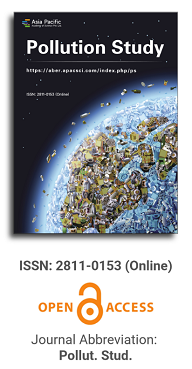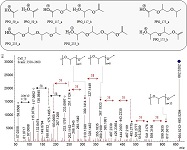
Asia Pacific Academy of Science Pte. Ltd. (APACSCI) specializes in international journal publishing. APACSCI adopts the open access publishing model and provides an important communication bridge for academic groups whose interest fields include engineering, technology, medicine, computer, mathematics, agriculture and forestry, and environment.

The (partial) replacement of synthetic polymers with bioplastics is due to increased production of conventional packaging plastics causing for severe environmental pollution with plastics waste. The bioplastics, however, represent complex mixtures of known and unknown (bio)polymers, fillers, plasticizers, stabilizers, flame retardant, pigments, antioxidants, hydrophobic polymers such as poly(lactic acid), polyethylene, polyesters, glycol, or poly(butylene succinate), and little is known of their chemical safety for both the environment and the human health. Polymerization reactions of bioplastics can produce no intentionally added chemicals to the bulk material, which could be toxic, as well. When polymers are used to food packing, then the latter chemicals could also migrate from the polymer to food. This fact compromises the safety for consumers, as well. The scarce data on chemical safety of bioplastics makes a gap in knowledge of their toxicity to humans and environment. Thus, development of exact analytical protocols for determining chemicals of bioplastics in environmental and food samples as well as packing polymers can only provide warrant for reliable conclusive evidence of their safety for both the human health and the environment. The task is compulsory according to legislation Directives valid to environmental protection, food control, and assessment of the risk to human health. The quantitative and structural determination of analytes is primary research task of analysis of polymers. The methods of mass spectrometry are fruitfully used for these purposes. Methodological development of exact analytical mass spectrometric tools for reliable structural analysis of bioplastics only guarantees their safety, efficacy, and quality to both humans and environment. This study, first, highlights innovative stochastic dynamics equations processing exactly mass spectrometric measurands and, thus, producing exact analyte quantification and 3D molecular and electronic structural analyses. There are determined synthetic polymers such as poly(ethylenglycol), poly(propylene glycol), and polyisoprene as well as biopolymers in bags for foodstuffs made from renewable cellulose and starch, and containing, in total within the 20,416–17,495 chemicals per sample of the composite biopolymers. Advantages of complementary employment in mass spectrometric methods and Fourier transform infrared spectroscopy is highlighted. The study utilizes ultra-high resolution electrospray ionization mass spectrometric and Fourier transform infrared spectroscopic data on biodegradable plastics bags for foodstuffs; high accuracy quantum chemical static methods, molecular dynamics; and chemometrics. There is achieved method performance |r| = 0.99981 determining poly(propylene glycol) in bag for foodstuff containing 20,416 species and using stochastic dynamics mass spectrometric formulas. The results highlight their great capability and applicability to the analytical science as well as relevance to both the fundamental research and to the industry.
Air quality in Bulgaria—Monitoring data, perspectives, scientific research
Vol 5, Issue 1, 2024
Download PDF
Abstract
This paper addresses air quality in Bulgaria, a pressing environmental issue with monitoring data indicating persistent challenges in urban areas due to pollutants like PM10 and NO2. Bulgaria’s government operates a comprehensive air quality monitoring network, offering real-time data to track pollutants across multiple regions. Scientific research in this area focuses on identifying pollution sources, assessing public health impacts, and developing models for pollution control. Efforts to improve air quality include implementing stricter regulations, investing in green technologies, and conducting public awareness campaigns. Future research emphasizes sustainable urban planning, the adoption of renewable energy, and advanced monitoring technologies to strengthen air quality management in Bulgaria.
Keywords
References
- Special report No 23/2018 Air pollution—our health is still not sufficiently protected. Available online: https://op.europa.eu/webpub/eca/special-reports/air-quality-23-2018/bg/ (accessed on 2 March 2024).
- Available online: https://commons.wikimedia.org/wiki/File:LocationPeoplesRepublicofBulgaria1988.png (accessed on 2 March 2024).
- Available online: https://commons.wikimedia.org/wiki/File:Bulgaria-geographic_map-bg.svg (accessed on 2 March 2024).
- Available online: https://www.mapsofindia.com/world-map/bulgaria/ (accessed on 2 March 2024).
- Available online: https://en.wikipedia.org/wiki/Geography_of_Bulgaria (accessed on 2 March 2024).
- Available online: https://en.bolgarskiydom.com/zhizn-v-bolgarii/regioni-klimat/ (accessed on 2 March 2024).
- Ordinance No. 14 of 23.09.1997 on norms for the maximum permissible concentrations of harmful substances in the atmospheric air of populated areas. Available online: https://eea.government.bg/bg/legislation/air/10Naredba14.pdf (accessed on 2 March 2024).
- Ordinance No. 7 on assessment and management of atmospheric quality air. Available online: https://eea.government.bg/bg/legislation/air/N7_OUKAV.pdf (accessed on 2 March 2024).
- Environmental Protection Act. Available online: https://www.legislation.gov.uk/ukpga/1990/43/pdfs/ukpga_19900043_en.pdf (accessed on 2 March 2024).
- REGULATION No. 12 of July 15, 2010 on sulfur dioxide standards, nitrogen dioxide, fine dust particles, lead, benzene, carbon oxide and ozone in the atmospheric air. Available online: https://eea.government.bg/bg/legislation/air/Naredba_12_Normi_KAV.pdf (accessed on 2 March 2024).
- Clean Air Act. Available online: https://en.wikipedia.org/wiki/Clean_Air_Act (accessed on 2 March 2024).
- Environmental Protection Act. Available online: https://www.moew.government.bg/en/environmental-protection-act-7628/ (accessed on 2 March 2024).
- LAW on the purity of atmospheric air. Available online: https://www.moew.government.bg/bg/zakon-za-opazvane-na-okolnata-sreda-8793/ (accessed on 2 March 2024).
- Environmental Protection law. Available online: https://eea.government.bg/bg/legislation/air/ZAKON_za_chistotata_na_atmosferniq_vazduh_22.pdf (accessed on 2 March 2024).
- Bulgarian National Environmental Monitoring System. Available online: https://eea.government.bg/en/nsmos/index.html (accessed on 2 March 2024).
- Zheleva I. Air Pollution Study for Bulgarian Part of Bulgaria-Romania Trans-Border Area. Journal of Theoretical and Applied Mechanics. 2023; 53(4). doi: 10.55787/jtams.23.53.4.404
- National report on the state and protection of the environment in the Republic of Bulgaria. Available online: https://eea.government.bg/bg/soer/2023/1Air.pdf (accessed on 2 March 2024).
- Available online: https://www.eea.europa.eu/themes/air/intro (accessed on 2 March 2024).
- Filipova M, Zheleva I, Roussev P. Characteristics of PM air pollution along Bulgaria—Romania Danube region, ECOLOGICA. 2013; 71: 215–217.
- Ivanov A, Gocheva-Ilieva S. Short-time particulate matter PM10 forecasts using predictive modeling techniques. AIP Conference Proceedings. 2013: 209–218. doi: 10.1063/1.4827230.
- Ivanov A, Voynikova D, Gocheva-Ilieva S, et al. Using principal component analysis and general path seeker regression for investigation of air pollution and CO modeling. AIP Conference Proceedings. 2015; 1685: 100004. doi: 10.1063/1.4934341
- Filipova M, Zheleva I, Rusev P, et al. Analysis of The State of Ambient Air in The Border Region Bulgaria Romania. SIMI 2016. 2016: 440–449. doi: 10.21698/simi.2016.0062
- Zheleva I, Filipova M. Atmospheric characteristics statistic study of Ruse region, Bulgaria. AIP Conference Proceedings. 2016; 1773: 110019. doi: 10.1063/1.4965023
- Zheleva I, Veleva E, Filipova M. Analysis and modeling of daily air pollutants in the city of Ruse, Bulgaria. AIP Conference Proceedings. 2017; 1895: 030007. doi: 10.1063/1.5007366
- Tsvetanova I, Zheleva I, Filipova M, et al. Statistical analysis of ambient air PM10 contami-nation during winter periods for Ruse region, Bulgaria. In: Proceeding of the NCTAM 2017—13th National Congress on Theoretical and Applied Mechanics; 2018. p. 01007.
- Stefanova A, Zheleva I, Filipova M, et al. Examination of the possibility of transborder pollution in the days with registered excee-dances of pollutant dust in the city of Ruse, Bulgaria. In: Proceeding of the NCTAM 2017—13th National Congress on Theoretical and Applied Mechanics; 2018. p.01004.
- Tsvetanova I, Zheleva I, Filipova M. Statistical study of the influence of some atmospheric characteristics upon the particulate matter (PM10) air pollutant in the city of Ruse, Bulgaria. AIP Conference Proceedings. 2018; 145: 110006. doi: 10.1063/1.5064949
- Veleva E, Zheleva I. GARCH models for particulate matter PM10 air pollutant in the city of Ruse, Bulgaria. AIP Conference Proceedings. 2018; 2025: 040016. doi: 10.1063/1.5064900
- Gocheva-Ilieva SG, Ivanov A. Assaying SARIMA and generalised regularised regression for particulate matter PM10 modelling and forecasting. International Journal of Environment and Pollution. 2019; 66: 41–62. doi: 10.1504/ijep.2019.104520
- Gocheva-Ilieva S, Ivanov A, Iliev I. Exploring key air pollutants and forecasting particulate matter PM10 by a two-step SARIMA approach. AIP Conference Proceedings. 2019; 2106: 020004. doi: 10.1063/1.5109327
- Tsvetanova I, Zheleva I, Filipova M. Statistical study of the influence of the atmospheric characteristics upon the particulate matter (PM10) air pollutant in the city of Silistra, Bulgaria. In: Application of Mathematics in Technical and Natural Sciences: 11th International Conference for Promoting the Application of Mathematics in Technical and Natural Sciences—AMiTaNS’19. 2019. p.120014.
- Veleva E, Georgiev IR, et al Markov chain modeling of particulate matter (PM10) air contamination in the city of Ruse, Bulgaria. AIP Conference Proceedings 2302. 2020: 060019. doi: 10.1063/5.0033530
- Veleva E, Zheleva I, Georgiev I. Decomposition techniques for modeling the levels of particulate matter (PM10) pollutant in the city of Silistra, Bulgaria. AIP Conference Proceedings 2302. 2020: 060019. doi: 10.1063/5.00335301
- Voynikova DS, Gocheva-Ilieva SG, Ivanov AV, et al. Studying the effect of meteorological factors on the SO2 and PM10 pollution levels with refined versions of the SARIMA model. AIP Conference Proceedings. 2015; 1685: 100005. doi: 10.1063/1.4934342
- Filipova M, Minkova I, Nikolova M, et al. Statistic study of air contamination in Bulgaria—Romania trans-border area. Part 1. Area chracteristics. In: Modern trends in development of chemical technology and engineering in the food and light industy. Publisher; 2023. pp. 26–30.
- Filipova M, Minkova I, Nikolova M, et al. Statistic study of air contamination in Bulgaria—Romania trans-border area. Part 2 Air contamination characteristics. Norms. Ecological monitoring. In: Modern trends in development of chemical technology and engineering in the food and light industry. Publisher; 2023. pp. 30–32.
- Filipova M, Minkova I, Nikolova M, et al. Statistic study of air contamination in Bulgaria—Romania trans-border area. Part 3. Results and disscusions. In: Modern trends in development of chemical technology and engineering in the food and light industy. Publisher; 2023. pp. 32–34.
- Gocheva-Ilieva SG, Ivanov AV. Assaying stochastic SARIMA and generalized regularized regression for particulate matter PM10 modeling and forecasting. International Journal of Environment and Pollution. 2019; 66: 41–62. doi: 10.1504/IJEP.2019.104520
- Gocheva-Ilieva S, Ivanov A, Iliev I. Exploring key air pollutants and forecasting particulate matter PM10 by a two-step SARIMA approach. AIP Conference Proceedings. 2016; 2106: 020004. doi: 10.1063/1.5109327
- Ivanov A, Voynikova D, Gocheva-Ilieva S, et al. Parametric time-series analysis of daily air pollutants of city of Shumen, Bulgaria. AIP Conference Proceedings. 2012: 386–396. doi: 10.1063/1.4758982
- Gocheva-Ilieva SG, Ivanov AV, Voynikova DS, et al. Time series analysis and forecasting for air pollution in small urban area: A SARIMA and factor analysis approach. Stochastic Environmental Research and Risk Assessment. 2014; 28(4): 1045–1060. doi: 10.1007/s00477-013-0800-4
- Gocheva-Ilieva S, Stoimenova M, Ivanov A, et al. Stochastic univariate and multivariate time series analysis of PM2.5 and PM10 air pollution: A comparative case study for Plovdiv and Asenovgrad, Bulgaria. AIP Conference Proceedings. 2016; 1773: 110004. doi: 10.1063/1.4965008
- Stoimenova M, Voynikova D, Ivanov A, et al. Regression trees modeling and forecasting of PM10 air pollution in urban areas. AIP Conference Proceedings. 2017; 1895: 030005. doi: 10.1063/1.5007364
- Ivanov A, Voynikova D, Stoimenova M, et al. Random forests models of particulate matter PM10: A case study. AIP Conference Proceedings. 2018; 2025: 030001. doi: 10.1063/1.5064879
- Gocheva-Ilieva SG, Ivanov AV, Livieris IE. High Performance Machine Learning Models of Large Scale Air Pollution Data in Urban Area. Cybernetics and Information Technologies. 2020; 20(6): 49–60. doi: 10.2478/cait-2020-0060
- Gocheva-Ilieva S, Ivanov A, Stoimenova-Minova M. Prediction of Daily Mean PM10 Concentrations Using Random Forest, CART Ensemble and Bagging Stacked by MARS. Sustainability. 2022; 14(2): 798. doi: 10.3390/su14020798
- Gocheva-Ilieva S, Ivanov A, Kulina H, et al. Multi-Step Ahead Ex-Ante Forecasting of Air Pollutants Using Machine Learning. Mathematics. 2023; 11(7): 1566. doi: 10.3390/math11071566
- Gocheva-Ilieva SG, Ivanov A, Stoimenova-Minova MP, et al. Discrete Wavelet Transform and Ensemble Tree Algorithms for Air Pollutant Modeling: A Case Study. International Journal of Membrane Science and Technology. 2023; 10(4): 1357–1373. doi: 10.15379/ijmst.v10i4.2251
- Stefanova A, Zheleva I, Filipova M. Deviation analysis using applicable methodologies for impact assessment on the ambient air component from industrial site in Razgrad, Bulgaria. AIP Conference Proceedings. 2018; 2025: 040014. doi: 10.1063/1.5064898
- Cretu M, Teleaba V, et al Air Pollution: Concern, Monitoring and Interpretation. Proceedings of Ruse University, Bulgaria. 2012; 51: 60–164.
- Convention on Long-Range Transboundary Air Pollution. Available online: https://www.state.gov/key-topics-office-of-environmental-quality-and-transboundary-issues/convention-on-long-range-transboundary-air-pollution/ (accessed on 2 March 2024).
- Available online: https://en.wikipedia.org/wiki/Vienna_Convention_for_the_Protection_of_the_Ozone_Layer (accessed on 2 March 2024).
Supporting Agencies
Copyright (c) 2024 Ivanka Zheleva
License URL: https://creativecommons.org/licenses/by/4.0/

This site is licensed under a Creative Commons Attribution 4.0 International License (CC BY 4.0).
.jpg)
Beijing University of Technology, China



